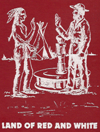 DAVID BRISTOW FAMILY
DAVID BRISTOW FAMILY
by Frank Bristow
My father, David Bristow, was born September 12, 1864 in Grey County, Ontario. He married Annie Zeggel in 1887. She was born October 20, 1866, also in Grey County, Ontario. In 1900 he came west with his wife and family; four sons, David, Fred, Dalton and Danny, and two daughters, Mary and Margaret, to Okotoks, Alberta. He was farming there until 1910. While there four more children were born; Isabel, Frank, tames and Nellie. Danny died there from an accident. In the fall of 1909 Dad got the urge to go homesteading, as he could get 160 acres for $10. After threshing was over, he went to Vermilion and there met up with an old school friend, Harry Bowtell, who was homestead inspector. Bowtell advised him to come to Frog Lake, as the railroad was supposed to come through in a couple of years. Father and brother Fred stayed with the Indian chief, John Horse, while they looked around for land. In December 1909 he filed on S.E. 1/4 of 24-56-4-4, with the three boys filing on land adjoining on three sides. He had a sale at Okotoks in the spring of 1910 and moved with the whole family.
With them came Billy Jamison and Bryce Crawford (nicknamed Scotty). Bryce filed a homestead on S.W. 3056-3-4. He worked for us and Harry Bowtell. He left the district in 1917 and joined the army. On his return he remained here for a short time before selling his homestead to Alex Peterson. The hill where he built his house was called Scotty's Hill for many years. The wooden bridge across the coulee at the bottom of the hill has been replaced by a culvert. The last I heard of him, I believe, was from Vulcan, Alberta.
My father shipped his machinery and household effects, and about forty head of horses to Kitscoty. He had a Case steam threshing outfit, several wagons, and a sleeping caboose for the threshing crew. Everything had to be hauled from there with horses and wagons, 40 miles to the homestead. The men came on to the homestead with the first loads. They crossed the river by Lea Park on a little ferry; there was no motor on it, only run by the current of the river. There were no road allowances and no fences, only a wagon track wound across the country in places of least resistance. This kind of a trail went as far as the Indian Reserve. They crossed the Frog Creek at the ford by Clearwater Lake. From then on they had to make their own trail through the bush. There was an open spot between our hill and where the present main road is now, the rest was all poplar and willow brush. That is where they pitched the tents and started on the first building. A corral was built where the barn is now, to keep some of the horses in for the first while. They got some hay from an Indian to feed the horses, and when they got out one morning an elk was standing there eating off the hay.
The women folks and the younger kids came by passenger train to Kitscoty and stayed there above the hardware store for a short while until the men got settled on the homestead. Then Fred came in with a team and democrat to bring us out. We got to Lea Park by noon and stopped for dinner at Charlie Pickles' place. He ran a little store by the Vermilion River. The ferry was run by a fellow by the name of Louie Patenaude, who lived in a shack on the north side of the river. It was my first experience in crossing the river by ferry. On the north side we had to follow a narrow trail through tall trees; further on it was open patches of land, but we never saw any buildings or fences. We came on to the homestead from the reserve, and when we saw the tents and sleeping caboose, my mother said it looked like a dreary place to make a home. She never saw a town for ten years after that.
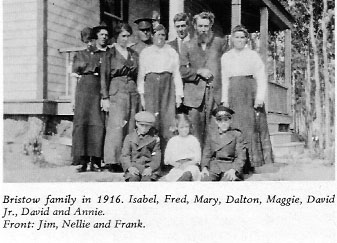
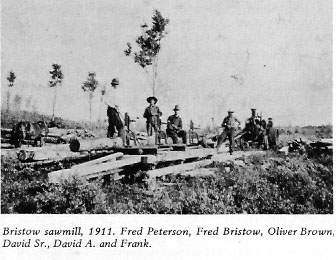
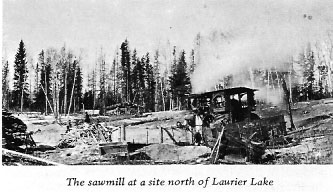
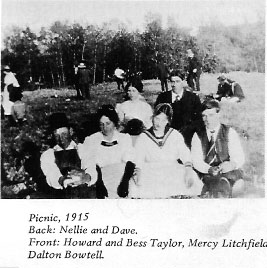
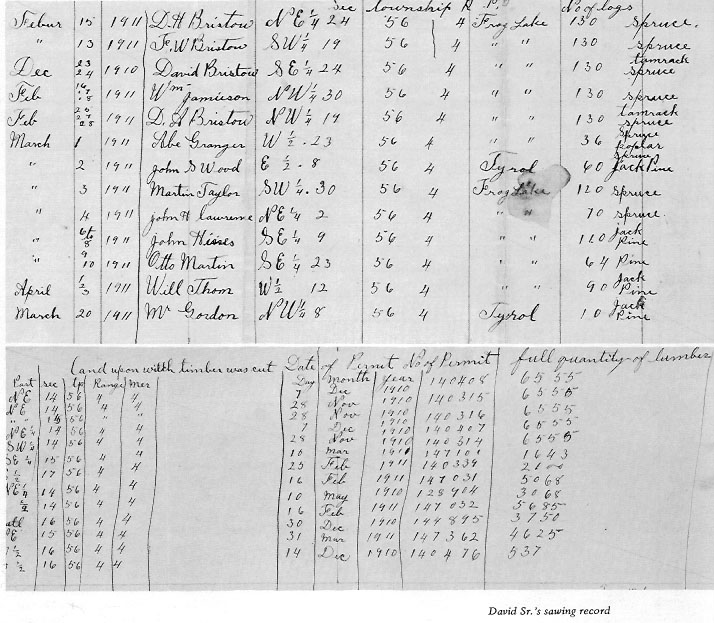

The first house, 16 feet by 24 feet, was built of logs taken from the coulee, hewed on two sides. Lumber was needed for the floor and roof, so Father drove to Shamrock Valley sawmill forty miles away to purchase that, also jack- pine shingles for the roof. Bryce Crawford was helping to build the house. He cut his foot so bad, and the doctor so far away. They did the best they could with home remedies. He was laid up quite awhile, but eventually healed alright. The first visitor we had was Jack Lawrence. He had a homestead by Ross Lake. He showed us how to notch the logs and also how to build a boat so we could go fishing. This was quite an experience for us, as we had never been near a lake before.
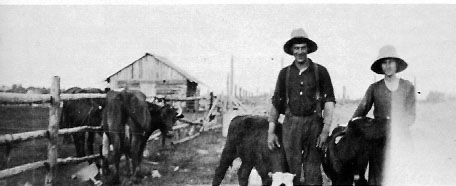
Mary and Maggie went fishing one day. The boat leaked a little, so they took their shoes and stockings off. They caught a big fish and were afraid to put it in the boat. They rowed to shore and killed the fish with the oar. Another time we were late coming back from fishing. We kids were sitting in the back of the democrat. Belle was leaning out picking the flowers off the fireweed when she fell out and the wheel ran over her and broke her arm. Mary and brother Dave drove all night to take her to Kitscoty to the doctor. Other early visitors whe had when we were still living in the tents were Henry Anderson, his wife, two boys, and Irene and Bob Chandler. They drove all the way from Mooswa with team and wagon.
That first summer quite a few people stopped at our place. They came looking for homesteads. Some found land, others never came back. In a few years people were living on nearly every quarter. One day at noon four covered wagons drove in, followed by a surrey with the fringe on top, and all the brass trimmings. They had followed our trail from Clearwater Lake. They had horses, mules, and one donkey. The women drove the surrey, the men the wagons. They came from Texas. The families belonged to John Heins, Will Thombs and Otto Martin. We had a shallow well in the coulee where they camped while looking for homesteads. One of the kids climbed a tree. He cut the limbs as he went up, then another kid cut the tree down. The first one fell down and broke his arm and had to be taken to the doctor with mules and wagon. The kid was Walter Thombs.
John Heins was the man that homesteaded north of Heinsburg; he had the first Heinsburg post office and a little store. Thombs homesteaded S.E. 13 56-44; that is where they built their home. He didn't know much about farming and picked some of the poorest land in the community. They didn't stay too many years. They got news that oil had been struck on some of their land in Texas. They all left and it was the last we saw of them. Several of the early homesteaders didn't stay very long. One of them was Mr. Allen, who homesteaded the place later taken by Ole Lunden. He had a big pole by his house with a flag on it that we could see from here. About once a week he would walk to Lea Park for the mail - twenty miles away and back the same day, and he would often bring our mail.
Quite often people would stop here while looking for homesteads; they wanted to know where the massacre ground was. There was no road or anyway to direct them, so sometimes some of our family would go with them. It was then only 25 years after the rebellion. At that time we could still see where the bottom logs of the buildings had been, where they had been laying in the dirt on the ground, so we could pretty well tell the size of the buildings. We could still see where the footpaths had been. North of the road where the steel bridge over Frog Creek is now, near the edge of the reserve, is the spot where they started to build the dam for a flour mill. The water wheel was laying on the bank of the creek on the east side at that time. We could still see the logs that were put in the creek to hold the dirt from washing away. They had been digging in the bank, mostly on the west side, and moved dirt by wheelbarrow into the dam. They hadn't got very far with it. There were some cellars not far from there, to the east, where some of the people lived; they had something to do with building the mill. One time when we were there some Indians were bringing in building logs not far south of there. Later that was where the Harry Bowtell residence was built, and the old house is still standing.
My father brought a Case steam threshing outfit with him. When they brought it to the homestead, they crossed Frog Creek at the ford where it comes out of the lake. They stopped there to take on water and fuel. When they started up again, there were many of the Indians gathered around. They had never seen anything like that before, this big thing moving along by its own power with all the steam and smoke and noise. As they got closer Dad gave a blast on the steam whistle, the Indians started to run for their lives, and some of the horses tried to run away, which caused lots of excitement for a few minutes. At that time gas tractors were not much of a success and pretty expensive to run. Diesel tractors were not even heard of. Steampower. was very reliable; it may have had something to do with why they came to this bush country, where there was lots of wood and water, which was all it took for power.
We used it quite a bit for clearing land. I have seen them pull trees a foot through, roots and all, and smaller ones several at a time; pulled them in big piles and burned them. We used it some for breaking but couldn't get plows strong enough at that time. They were broken down a lot of the time. Then it was so big and heavy, and if it hit soft spots it got stuck so bad we lost a lot of time getting it out. Most of the breaking was done by horses. There was a lot of free range then, that is why they brought so many horses. There was good demand for them. The first year or two we lost so many of them in one way or another, with swamp fever, getting stuck in the swamps, straying away, or trying to get back across the river.
My father bought a sawmill from S.E. Barstad, Lea Park, Alberta. After that we sawed all our own lumber and also all of the homesteaders' logs. Each homesteader could get a free permit for a certain number of them. The first time we had it set up by the spring on the place that was later homesteaded by Rudolph Gregor, and we sawed a good many logs there. Another time it was on the north side of Laurier Lake, on the west side of the Red Water creek and the narrows. At that time there were no roads on the north side of the lake; it was all heavy bush, so we crossed on the ice on the lake. The men had a log house where they stayed, but we took provisions over most every day. The lumber was all hauled out over the lake and we had to hurry in the spring to get the heavy steamer and outfit out before the ice got too weak. There wasn't any school here, so in 1912 my father rented a place from Jack Johnston, two miles south of Lea Park, so we kids could go to Elgin School.
Mother and Dad and us younger kids moved down there, while the older brothers and sisters stayed at the homestead. It wasn't much of a success as we had four or five miles to go to school. We drove or rode horseback, but the school was only operating in the summer months. At that time there was a lot of vacant land where we could cut prairie wool hay, so we had lots of good horse feed. There was much freighting to Kitscoty from all over this country, as far north as Cold Lake. Freighters used to stop at our place. Fishing went on all winter long at Cold Lake, and the fish was hauled to Kitscoty with sleighs and horses, and some with oxen. Phillips and Marshall bought and shipped sixteen or eighteen carloads out of there one winter, all hauled from Cold Lake. One time we had twenty-three outfits stay overnight. I don't know how my folks managed, as they only had a small house, but there was never anyone turned away.
In 1914 a school was built here on the S.E. corner of this homestead, so we moved back up here again. After Dad had the sawmill he built the frame part (18 feet by 30 feet) on to the log house. It was pretty well completed in 1912, as we had the wedding dance for my sister Mary here. There were a good many dances held in this house, including the wedding dances for three of my sisters. Church services were held here, also elections, political meetings and many social gatherings. Mother was a good manager and a good cook; always seemed to make a good meal even before the time of refrigeration. She always had a good garden. She raised nine of a family. When Dad had the steam threshing outfit, and the weather turned bad, lots of times the whole gang of eight to ten men came home without any notice. She always managed to make a meal without any complaint. The only holiday she ever had after she came to the homestead was when she and Nellie went to Ontario to visit relatives in the winter of 1919-20.
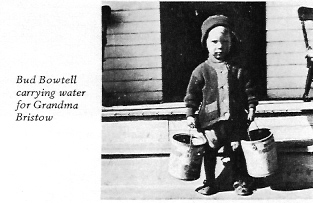
My father was a fairly big man and a hard worker. He was always busy with something. When the weather wasn't fit to work outside, he had something to do inside. He was handy with carpentry work and most other repair work, and he kept the buildings and fences in good repair. He was always active in community affairs. He cleared most of the bush off the homestead with an axe. He did mixed farming mostly. He sometimes raised a couple of thousand bushels of wheat, but it was 40 miles to haul it with horses, which took three days each trip. Most other grain was fed to the hogs. Most of the cattle they raised had to be driven to market, and it took several days. He never saw the completion of the railroad that he had waited for so many years, and it must have been a big disappointment for him. He passed away December 23, 1925 at 61 years of age. Mother lived 'til January 2, 1936. She was 69 years of age.


